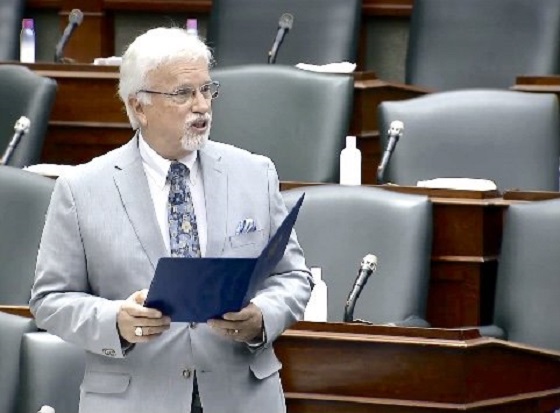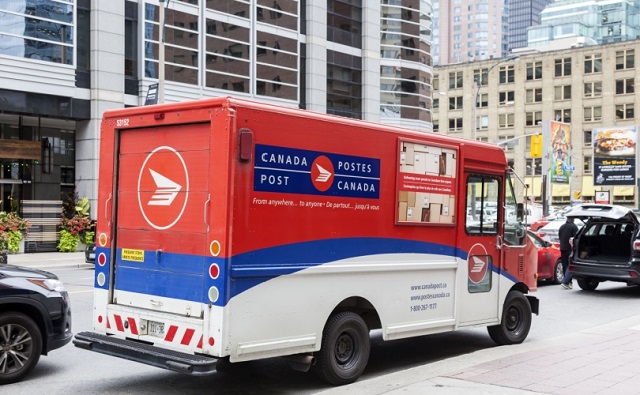Alberta
Alberta bans fires in provincial parks, protected areas, hiring 200 new firefighters, increasing fines & more

The Albert government is taking a number of steps to reduce the risk of spring wildfires while protecting municipalities.
Alberta Wildfire is hiring 200 additional firefighters, invoking a fire ban, implementing off-highway vehicle (OHV) restrictions, increasing fine violations and funding $20 million more in community FireSmart initiatives, all to prepare for the upcoming wildfire season during COVID-19.
Alberta Parks is also instituting a fire ban in all provincial parks and protected areas.
These early preparedness measures will ensure the province can effectively focus resources where they are needed most in the event of multiple emergencies happening at the same time.
Typically, the wildfire hazard is highest in Alberta in late April through May, when fuel like trees and grasses have extremely low moisture content after the snow has melted.

A massive wildfire swept through parts of Fort McMurray in May 2016, leading to the evacuation of the population and billions in damages. Photo Courtesy/Government of Alberta
More than a million acres burned last year and 71 per cent of wildfires were human-caused and entirely preventable. With provincial resources currently stretched due to COVID-19, these preventative measures will better equip Alberta’s response to spring wildfires this year.
“Albertans are tough and we’re all doing what we can to keep each other safe during COVID-19. With Alberta’s wildfire season matching with the expected peak of COVID-19, we have to take extra precautions to ensure our response efforts are well-funded and planned out. This spring, we may find ourselves facing multiple disasters at once. With all these measures, we will be prepared.” Devin Dreeshen, Minister of Agriculture and Forestry
Increased firefighting resources
An additional $5 million investment is being made to hire and train 200 high-quality firefighters to assist with the provincial wildfire suppression this season.

The fire ban and OHV restriction are temporary measures, which will remain in place only as long as required to combat the wildfire risk.
More than 800 seasonal firefighters will join 370 year-round staff at Alberta Wildfire. These resources are hired at one of the 10 Forest Areas, and are moved throughout the Forest Protection Area as required.
Fire ban and OHV restriction
A fire ban in the Forest Protection Area, provincial parks and protected areas, as well as a recreational OHV ban on Crown land in the Forest Protection Area, will come into effect April 15.
Alberta’s Forest Protection Area covers almost 60 per cent of Alberta, most of the northern half of the province and the western border, excluding federal parks.
The government recognizes that many Albertans use OHVs and respects this valid activity. At the same time, the government must take into account limitations and manage risk due to the COVID-19 pandemic. Hot mufflers can potentially start wildfires.
The fire ban and OHV restriction are temporary measures, which will remain in place only as long as required to combat the wildfire risk. Measures may later be adjusted to take into account the needs of specific regions.
All fire permits will be suspended in this area, and landowners are responsible for ensuring any holdover fires are extinguished by this time.
Indigenous people may use OHVs on public land for traditional purposes. Use of OHVs on private lands, for industrial use (for example forestry, agriculture and energy) and by emergency responders is also permitted.

A recreational off-highway vehicle (OHV) ban on Crown land in the Forest Protection These OHV restrictions are only temporary measures.
Fines are being doubled from $300 to $600 for non-compliance with a fire ban and from $600 to $1,200 for non-compliance with an OHV restriction. With 71 per cent of last year’s wildfires started by people, these fine increases reflect the seriousness of the preventative measure Albertans must take to prevent wildfires.
Individuals found contravening a fire ban or OHV restriction will be subject to increased fines, starting April 15, and could be held liable for all costs associated with fighting a wildfire. Last year, more than $600 million was spent fighting wildfires in Alberta.
These fines are in addition to the existing penalties for arson under the Criminal Code.
“Our province is taking steps to prepare for wildfires and other hazards this spring and summer by increasing our emergency response capacity. This means that while we continue to respond to the COVID-19 pandemic, we will also be ready to respond to other emergencies as they may arise.” Kaycee Madu, Minister of Municipal Affairs
Increased FireSmart funding
FireSmart will receive a funding boost of up to $20 million to support vegetation management in the province. The department will work with municipalities to ensure these funds are used this fiscal year.
FireSmart helps to reduce the wildfire risk to Albertans, their homes and communities. The FireSmart program includes grants to support the most at-risk communities in Alberta, including Indigenous communities.
This additional funding will help mitigate wildfire damages and losses in more Alberta communities by creating FireSmart zones around at-risk communities to reduce wildfire hazards.
To increase response capacity and prepare for multiple and concurrent disasters, such as wildfires and floods, the Provincial Operations Centre has been reinforced by the creation of a Pandemic Response Planning Team. This team will help coordinate government’s medium and long-term response to the COVID-19 pandemic.
Quick facts
- For more information on wildfires, download the Alberta Wildfire app.
- Up-to-date information on fire restrictions, fire bans, OHV restrictions and general wildfire information is available at albertafirebans.ca or by calling 1-866-FYI-FIRE (1-866-394-3473).
- To report a wildfire, call 310-FIRE (310-3473) toll-free, from anywhere in Alberta.
- Most new seasonal staff will be on-the-ground firefighters, with wages between $22 and $28 per hour.
- Fire bans and OHV restrictions have proven to be effective prevention tools in reducing the number of human-caused wildfires.
- Anyone found to be non-compliant with a fire ban or OHV restriction may also have to go to court and may receive a fine up to $100,000. Anyone found to be the cause of a wildfire may be liable for the costs associated with extinguishing the fire.
- FireSmart is a program that requires cooperation of all people living, working and playing in the forest.
Alberta
Alberta’s vision for passenger rail

Alberta’s government will develop a Passenger Rail Master Plan as the foundation to advancing passenger rail in the province.
Since the early days of Alberta’s development, the province has been shaped by the iron rails that crisscross its landscape. The arrival of the transcontinental railway in the late 19th century brought about profound changes to the way of life, facilitating trade, settlement, and economic prosperity. Towns and cities sprung up along the tracks, serving as vital hubs for commerce and transportation.
Today, the legacy of rail continues to shape Alberta and the rest of Canada. While the modes of transportation may have evolved, the spirit of innovation and connectivity remains as strong as ever. As Alberta experiences record population growth and evolving transportation needs, advancing passenger rail infrastructure is essential for enhancing accessibility, efficiency, and connectivity across the province.
Alberta’s Passenger Rail Master Plan will look forward decades and identify concrete actions that can be taken now as well as in the future to build the optimal passenger rail system for the province. The Master Plan will assess the feasibility of passenger rail in the province, including regional (inter-city), commuter and high-speed services.
“A large and efficient passenger rail network stretching across the province has incredible potential. It represents a forward-looking vision and is a mobility solution for our rapidly growing province and I’m excited to watch this plan take shape and bring us into the future. There’s a lot of work ahead of us, but I’m confident that we will build the network Albertans need to improve daily life and work, boost the economy and take away the stress of long-distance travel.”
“Alberta already has significant public mass transit systems in Calgary and Edmonton for the provincial passenger rail system to build upon. The Master Plan will be a vital tool to guide the province on the next steps in advancing passenger rail. It will provide certainty to the rail sector and ensure the most effective use of tax dollars and government authorities. We look forward to hearing from Albertans and working with municipalities, Indigenous communities and the private sector in advancing passenger rail in the province.”
Passenger rail services connected to urban mass transit shapes and strengthens regional transportation systems, connects communities, supports jobs and the economy and improves access to housing.
“Canada’s railways appreciate the Alberta government’s efforts to conduct a fact-based study on the potential for passenger rail service that recognizes the essential need to protect current and future freight rail capacity. Any proposal to co-locate passenger service in freight corridors must demonstrate the ability to preserve the freight rail capacity required to move goods in support of the province’s economy, today and tomorrow. Rail is the greenest mode of ground transportation for both people and goods.”
The government’s vision is for an Alberta passenger rail system that includes public, private or hybrid passenger rail, including:
- a commuter rail system for the Calgary area that connects surrounding communities and the Calgary International Airport to downtown;
- a commuter rail system for the Edmonton area that connects surrounding communities and the Edmonton International Airport to downtown;
- regional rail lines from Calgary and Edmonton to the Rocky Mountain parks;
- a regional rail line between Calgary and Edmonton, with a local transit hub in Red Deer;
- municipal-led LRT systems in Calgary and Edmonton that integrate with the provincial passenger rail system; and
- rail hubs serving the major cities that would provide linkages between a commuter rail system, regional rail routes and municipal-led mass transit systems.
The vision includes a province-led “Metrolinx-like” Crown corporation with a mandate to develop the infrastructure and oversee daily operations, fare collection/booking systems, system maintenance, and planning for future system expansion.
“At VIA Rail our vision for integrated mobility means dreaming of a future where a passenger can easily switch between commuter rail, light transit, transit buses, and regional trains in an agile and simple way. We’ve already initiated a number of exchanges with partners, and we intend to step up the pace in the coming months and years. I can assure you that as integrated mobility becomes an increasingly important topic of conversation in Alberta, VIA Rail will be there to play a unifying role.”
Alberta’s Passenger Rail Master Plan will ensure government has the required information to make decisions based on where passenger rail delivers the best return on investment. The plan will provide a cost-benefit analysis and define what is required by government, including a governance and delivery model, legislation, funding, and staging to implement passenger rail in Alberta. This work will include a 15-year delivery plan that will prioritize and sequence investments.
“We are excited to see the province taking the next step in committing to regional and intercity rail. This Passenger Rail Master Plan aims to set out a vision for a comprehensive rail network in our province that’s long overdue. We are thrilled to see this process move forward.”
The Master Plan will take into account future growth, planning for the growing provincial population and considering the use of hydrogen-powered trains to ensure a robust and effective passenger rail system to serve Albertans for years to come.
Development of the Master Plan will include engagement with Albertans to gain their perspectives for the future of passenger rail in Alberta.
Alberta’s government has released a Request for Expression of Interest to seek world-class knowledge and consultant services as a first step toward the development of the Passenger Rail Master Plan for Alberta. Following this process, a Request for Proposal will be issued to select a consultant to develop the Passenger Rail Master Plan. The Master Plan is expected to be completed by summer 2025.
Quick facts
- Passenger rail includes:
- Commuter rail – passenger rail that primarily operates within a metropolitan area, connecting commuters to a central city from adjacent suburbs or surrounding commuter towns, and is often traditional heavy-rail
- Regional rail – passenger rail that operates beyond the limits of urban areas and provides inter-city passenger rail transport services and can be traditional heavy-rail or high-speed rail
- Light-rail transit (LRT) – urban passenger rail transit that typically operates small, frequent train service in an urban area. Calgary and Edmonton use LRT as part of their mass transit systems
- Passenger rail in Alberta is currently limited to two tourism-focused services, VIA Rail and Rocky Mountaineer, and LRT in Calgary and Edmonton.
- Budget 2024 includes $9 million to support the development of the Passenger Rail Master Plan this year.
Alberta
Three Calgary massage parlours linked to human trafficking investigation

News release from the Alberta Law Enforcement Response Team (ALERT)
ALERT’s Human Trafficking unit has searched and closed three Calgary massage parlours. A year-long investigation has linked the businesses and its owner to suspected human trafficking.
ALERT arrested Hai (Anna) Yan Ye on April 16, 2024 and charged the 48-year-old with advertising sexual services, drug offences and firearms offences. The investigation remains ongoing and further charges are being contemplated.
Ye was linked to three commercial properties and two homes that were allegedly being used for illegal sexual activities and services. The massage parlours were closed following search warrant executions carried out by ALERT, the Calgary Police Service, and the RCMP:
- Seagull Massage at 1034 8 Avenue SW;
- 128 Massage at 1935 37 Street SW; and
- The One Massage Centre at 1919 31 Street SE.
- 1100-block of Hidden Valley Drive; and
- 3100-block of 12 Avenue SW.
As result of the search warrants, ALERT also seized:
- $15,000 in suspected proceeds of crime;
- Shotgun with ammunition; and
- Various amounts of drugs.
“We believe that these were immigrants being exploited into the sex trade. This has been a common trend that takes advantage of their unfamiliarity and vulnerability,” said Staff Sergeant Gord MacDonald, ALERT Human Trafficking.
Four suspected victims were identified and provided resources by ALERT’s Safety Network Coordinators.
ALERT’s investigation dates back to February 2023 when a tip was received about suspicious activity taking place at the since-closed Moonlight Massage. That location was closed during the investigation, in December 2023, when the landlord identified illegal suites on the premises.
The investigation involved the close cooperation with City of Calgary Emergency Management and Community Safety, Alberta’s Safer Communities and Neighbourhoods (SCAN) team, Canada Border Services Agency (CBSA), and the RCMP.
Ye was released from custody on a number of court-imposed conditions.
Anyone with information about this investigation, or any case involving suspected human trafficking offences, is asked to call Crime Stoppers at 1-800-222-TIPS (8477) or the Calgary Police Service non-emergency line at 403-266-1234.
ALERT was established and is funded by the Alberta Government and is a compilation of the province’s most sophisticated law enforcement resources committed to tackling serious and organized crime.
-

 Business1 day ago
Business1 day agoOttawa’s capital gains tax hike—final nail in ‘business investment’ coffin
-

 Automotive1 day ago
Automotive1 day agoCanadian interest in electric vehicles falls for second year in a row: survey
-

 Alberta14 hours ago
Alberta14 hours agoAlberta’s vision for passenger rail
-

 Alberta1 day ago
Alberta1 day agoAlberta threatens to fight Trudeau government restrictions on Canada’s plastics industry
-

 COVID-191 day ago
COVID-191 day agoFormer Canadian lawmaker has no regrets about refusing COVID shot despite losing his job
-

 Alberta1 day ago
Alberta1 day agoCanada’s postal service refuses to help with Trudeau’s gun ban buyback program: report
-

 COVID-191 day ago
COVID-191 day agoPeckford: Hallelujah! Supreme Court of Canada to hear Newfoundland and Labrador charter case
-

 Fraser Institute2 days ago
Fraser Institute2 days agoFederal government’s fiscal record—one for the history books









